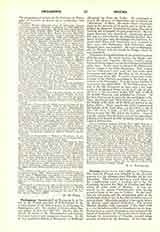

Philoxenus (AKHSENAYA) of MABBOGH, b. at Tahal, in the Persian province of Beth-Garmai in the second quarter of the fifth century; d. at Gangra, in Paphlagonia, 523. He studied at Edessa when Ibas was bishop of that city (435-57). Shortly after he joined the ranks of the Monophysites and became their most learned and courageous champion. In 485 he was appointed Bishop of Hierapolis, or Mabbogh(Manbidj) by Peter the Fuller. He continued to attack the Decrees of Chalcedon and to defend the “Henoticon” of Zeno. He twice visited Constantinople in the interests of his party, and in 512 he persuaded the Emperor Anastasius to depose Flavian of Antioch and to appoint Severus in his stead. His triumph, however, was short-lived. Anastasius died in 518 and was succeeded by the orthodox Justin I. By a decree of the new ruler the bishops who had been deposed under Zeno and Anastasius were restored to their sees, and Philoxenus, with fifty-three other Monophysites, was banished. He went to Philippopols, in Thrace, and afterwards to Gangra where he was murdered.
Philoxenus is considered one of the greatest masters of Syriac prose. He wrote treatises on liturgy, exegesis, moral and dogmatic theology, besides many letters which are important for the ecclesiastical history of his time. Notice must be taken of the Philoxenian Syriac version of the Holy Scriptures. This version was not Philoxenus’s own work, but was made, upon his request and under his direction, by the chore pisco pus Polycarp about 505. It seems to have been a free revision of the Peshitta according to the Lucian recension of the Septuagint. It is not known whether it extended to the whole Bible. Of the Philoxenian version of the Old Testament we have only a few fragments of the Book of Isaias (xxviii, 3-17; xlii, 17-xlix, 18; lxvi, 11-23) preserved in Syr. MS. Add. 17106 of the British Museum, and published by Ceriani. Of the New Testament we have the Second Epistle of St. Peter, the Second and Third Epistles of St. John and the Epistle of St. Jude, all of which are printed in our Syriac Bibles. There remain also a few fragments of the Epistles of St. Paul (Rom., vi, 20; I Cor., i, 28; II Cor., vii, 13; x, 4; Eph., vi, 12), first published by Wiseman from Syr. MS. 153 of the Vatican. Gwynn is of the opinion that the Syriac text of the Apocalypse published by himself in 1897 probably belongs to the original Philoxenian.
A. A. VASCHALDE

